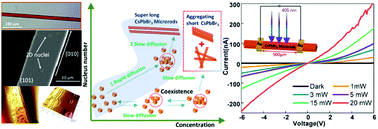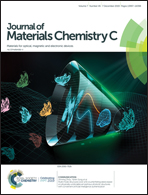Nucleation-controlled growth of superior long oriented CsPbBr3 microrod single crystals for high detectivity photodetectors
Abstract
There has been great interest in the use of cesium lead bromide (CsPbBr3), which is one of the most important members of the all-inorganic perovskite family, due to its superior optoelectronic performance and higher stability. Recently, it has been demonstrated that it is advantageous to use CsPbBr3 microrods and nanowires in photodetectors because of their higher crystallinity, low amount of defects, and easy control of carrier transport along a specific direction as compared to their counterparts of single crystals and thin films. However, there is a shortage of adequate investigations that describe how to control the growth of CsPbBr3 microrods and nanowires so that they retain the optoelectronic performance of single CsPbBr3 microrods. Therefore, we are reporting how to control the growth of orientated dispersive super-long CsPbBr3 microrod single crystals (CsPbBr3 MSCs) via a simple anti-solvent method. The crucial factor in controlling the growth of dispersive super-long CsPbBr3 MSCs is the regulation of the rapid nucleation rate and slowing of the growth rate via controlling the diffusion velocity of anti-solvent methanol. We also reveal the growth mechanism of CsPbBr3 MSCs as layer-by-layer growth that originates from the 2D nucleus. The CsPbBr3 MSCs are revealed grew in the direction of [010], with the (101) facet exposed. Moreover, photodetectors based on one CsPbBr3 MSC were fabricated, and the detectivity (D) and the on/off ratio were as high as 3.67 × 1012 Jones and 988, respectively, suggesting a very strong optoelectronic response as photodetectors. The mechanism that the Cs ions and Cs vacancies use to move to negative and positive electrodes along the channels constructed by [PbBr6]4− in the [010] direction of the CsPbBr3 MSC (101) facet was revealed, after activation by the applied electrical field, which is beneficial to enhance the optoelectronic response but does not reduce the device stability.



 Please wait while we load your content...
Please wait while we load your content...